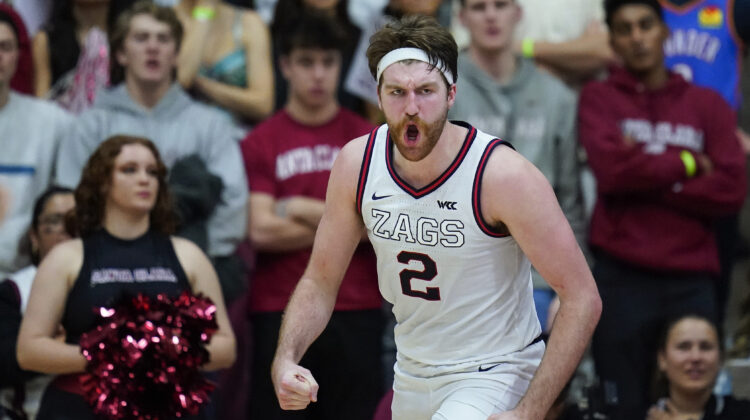Pac-12 executives visited SMU’s campus last week and are also considering San Diego State as an expansion candidate. The merits of both have been discussed and debated for months. Their fates should be determined within weeks.
But we cannot ignore the elephant in the region: Should the university presidents offer membership to Gonzaga?
The Bulldogs are the best basketball program in the Pac-12 footprint that isn’t in the Pac-12.
They are the only program remotely capable of filling the void left behind when UCLA leaves for the Big Ten in the summer of 2024.
They are the only program that could stand as a second tentpole, alongside Arizona, in a reconfigured conference.
It’s an intriguing idea, one worthy of consideration for Pac-12 as it sorts through the membership options and awaits a media rights contract:
The conference could hunker down and move forward with 10 schools.
It could add San Diego State and SMU for all sports.
What about adding SDSU for everything, SMU for football only and Gonzaga for all other sports.
Or how about this: Add San Diego State and Gonzaga in all sports and Boise State in football, thereby aggregating the best of the Zags and Broncos to create a single Power Five-worthy member.
But Gonzaga brings complications unlike any other option.
Would the presidents of the 10 secular universities welcome a Jesuit school?
Would Washington and Washington State approve elevating Gonzaga’s athletic profile?
Also, does expanding from within make strategic sense? In the two instances of expansion in the past half century, the conference has grown its borders: with the Arizona schools in 1978; and with Utah and Colorado in 2011.
The Zags could be viewed as a defensive play. Big 12 commissioner Brett Yormark has made no secret of his desire to move into the Pacific Time Zone and values basketball for his powerhouse league. How would the Pac-12 feel about the Big 12’s banner flying in the Palouse?
The solution to every problem, the answer to every question, is money.
Are the Zags a value add for the Pac-12? Would they increase the annual revenue for the existing members?
It depends, in part, on their asking price. (They aren’t coming for free, after all.)
To establish a baseline, let’s assume the Pac-12 could sign a media rights deal that spins off $30 million per campus annually.
Typically, basketball is worth about 20 cents for every media dollar, so we’ll assign $6 million (of the $30 million) for each school’s hoops program.
Are the Zags worth more than $6 million? Assuredly so.
— They are an NCAA Tournament stalwart and have averaged 3.5 units per year for the past decade. (Every game played is a unit.)
At $350,000 per game (the approximate value of a unit this year), that’s more than $1 million per year. And because the units carry forward for six years, the Zags generate about $7 million annually in units. Meanwhile, the Pac-12 average is about $1.5 million.
Even if we reduced Gonzaga’s average to 2.5 units per year as a Pac-12 member to account for more regular-season losses (from tougher competition), lower seeds, tougher early-round games and slightly less success, the Zags would be a cash machine compared to the typical Pac-12 program.
— Gonzaga also does well on television.
Against Power Five opponents over the past five years, the Zags have averaged 900,000 viewers, according to data provided to the Hotline by a media industry source. By comparison, UCLA has averaged 450,000 viewers, and the Pac-12 average is closer to 200,000.
That said, some context is required. Whereas Gonzaga’s matchups with Power Five opponents are high-profile, non-conference affairs that often get premier broadcast slots, UCLA’s audience data includes dozens of conference games against second-tier foes that don’t move the ratings needle. So let’s be cautious before assigning Gonzaga twice the audience value that UCLA generates.
But we don’t need the exact ratings to know the Zags rate better than the typical Pac-12 program.
For the sake of this exercise, let’s say Gonzaga carries a media rights value of $12 million annually, twice the Pac-12 average for basketball ($6 million) within our estimated media rights deal.
That sounds great, but again, it’s complicated. Whatever media dollars accompany Gonzaga into the conference must be split 11 ways. Naturally, the Zags will demand a share of the total annual revenue — not a full share because they don’t play football, but a significant enough slice to justify the move from kingfish status in the West Coast Conference.
Let’s use another round number: $10 million. In order for Gonzaga to join the conference, the school would require a flat payment of $10 million annually.
Subtract that from the total valuation, then split the remainder 10 ways, and we’re left with $30.2 million per school.
That’s a mere $200,000 bump. Even if we add the revenue from Gonzaga’s estimated NCAA Tournament units (split 11 ways), that doesn’t push the annual revenue accretion to $1 million per school.
To be clear: This is merely a back-of-the-envelope exercise intended to explain the financial calculation at the heart of the Gonzaga question.
The presidents surely will assess the subjective factors, as well, with institutional fit atop the list.
And the conference has undoubtedly discussed basketball options with its potential media partners during the ongoing negotiations.
Lastly, we should mention the long-haul piece. Gonzaga’s Mark Few is 60 years old. Will he coach three more years? Five more? Ten more? And what does Gonzaga basketball look like in the post-Few era?
If the Zags aren’t a top-25 program, they carry little value to the Pac-12. In fact, they could be dilutive.
The Hotline has discussed Gonzaga as a potential expansion target for months with contacts throughout the college basketball and sports media industries, and there is no consensus.
They are a tentpole program now, but what about in 10 or 15 years?
They carry more value than the Pac-12 average, but given basketball’s secondary position in the media rights space, is it enough to make the 11-way split work?
Is it enough for the Washington schools to approve?
Our hunch, and it’s nothing more: Because there’s no consensus, because there are complications, because the accretion piece is unclear, the Pac-12 is unlikely to extend a membership invitation.
*** Send suggestions, comments and tips (confidentiality guaranteed) to pac12hotline@bayareanewsgroup.com or call 408-920-5716
*** Follow me on Twitter: @WilnerHotline
*** Pac-12 Hotline is not endorsed or sponsored by the Pac-12 Conference, and the views expressed herein do not necessarily reflect the views of the Conference.
Related posts:
 Wilner Hotline – Pac-12 on the brink: USC and UCLA expected to seek membership in the Big Ten
Wilner Hotline – Pac-12 on the brink: USC and UCLA expected to seek membership in the Big Ten
 Pac-12 survival: What to make of Big Ten expansion plans, Oregon’s search for an escape hatch and the Big 12 option
Pac-12 survival: What to make of Big Ten expansion plans, Oregon’s search for an escape hatch and the Big 12 option
 Hotline mailbag: Detailing the Pac-12’s liabilities, the ‘Pac-2’ and the MW, future of the NW rivalries, CFP rules, Bay Area regret and more
Hotline mailbag: Detailing the Pac-12’s liabilities, the ‘Pac-2’ and the MW, future of the NW rivalries, CFP rules, Bay Area regret and more
 Wilner – Vision for the future of Pac-12 football: It’s 2033, and the conference has reformed with the old guard
Wilner – Vision for the future of Pac-12 football: It’s 2033, and the conference has reformed with the old guard


